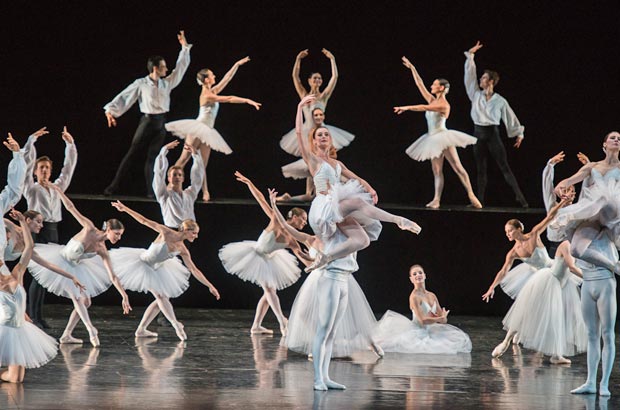
© Stephanie Berger. (Click image for larger version)
Paragons of Style
Paris Opera Ballet
French masters of the 20th Century: Suite en Blanc, L’Arlésienne, Bolero
New York, David H. Koch Theater
11 July 2012
www.operadeparis.fr
As part of the Lincoln Center Festival, the Paris Opera Ballet is in town for the first time in sixteen years (until July 22), introducing the local folk to a host of distinguished, refined ballerinas, most of them known to them only by reputation. Despite the company’s prestige, the American public seldom gets to glimpse the art of French dancers; in recent years, for example, no French étoiles have appeared in American Ballet Theatre’s guest-studded spring seasons at the Met. That company tends to favor Russian imports, with the odd Cuban or Italian thrown in for good measure. In a way, it’s easy to understand why—Russia seems to produce a steady stream of showstopping bravura dancers who leave audiences agog and begging for more. The Parisian style is rather more subtle, and certainly less attention-grabbing. Béjart’s Boléro aside, (but more on that later).
In any case, the Paris Opéra is one of the world’s great companies, whose origins are synonymous with that of ballet itself. Louis XIV, an avid dancer, founded the Académie Royale de la Danse in 1669 so that his fellow aristocrats would not make fools of themselves in the court ballets he so enjoyed; the first professional ballet academy was established in Paris in 1713. To this day, the positions learned by all young dancers bear French names. (This is one of the marvelous things about ballet: a student can go anywhere in the world and take class, without feeling the least bit lost. For that, we must thank Louis XIV.)
This legacy is not taken lightly. As Patrice Bart, a former étoile who is now an important ballet master in the company told the dance writer Marc Haegeman, “you can still say that the French school is the essence of classical ballet….Children [at the school] receive from the very beginning a certain mark, a ‘factory label,’ so to speak: exercises, steps, everything is done according to a certain manner.” In her New York Times preview of the season, Roslyn Sulcas stressed the same notion: “From the age of 8, the children are coached in the placement of the head, arms and hips known as épaulement, in precise footwork and small beaten jumps. The accent [is] on grace, line and legibility.” (By contrast, the training of the School of American Ballet, the academy associated with New York City Ballet, stresses speed, dynamism, and most important of all, musicality.) Observe the school and you will better understand the company.

© Stephanie Berger. (Click image for larger version)
As a result, the French dancers, especially the corps, exhibit a remarkable uniformity of style, all heads tilted just so, arms forming the same gracefully rounded curve (with softer elbows than either the Americans or the Russians), legs held at precisely the same height, feet rigorously pointed and presented to the audience like expensive objects to be admired. The esthetic level of the company is very, very high: never have I seen such a collection of beautiful bodies and faces as these past two nights at the Koch Theatre in Lincoln Center. And that goes for the men as well. (The women’s maquillage is also particularly lovely, bringing out the eyes, the cut of the jaw, the high cheekbones, the delicately-shaped but womanly lips.) It is nice to be in the company of so many beautiful women.
This New York run, part of a tour that has already taken the company to Chicago and Washington D.C., is composed of three separate programs, the first of which is an all-French mixed bill, entitled “French masters of the 20th Century.” (The company will also perform Giselle and Pina Bausch’s Orpheus and Eurydice.) The composers on the program are all French—Édouard Lalo, Bizet, and Ravel, all superbly played by the excellent New York City Opera orchestra, under the baton of Koen Kessels. (If only our local ballet orchestras played half as well.) The choreographers, too, have strong French ties. Serge Lifar, Balanchine’s original Apollo from his Ballets Russes days, was born in Kiev, but spent his entire adult life in France. He was the company’s artistic director from 1930 and 1958, largely defining the style for the twentieth century. Roland Petit, a dapper man who also made dances for the Casino de Paris and the movies, was the very essence of the parisien (down to the messy love life). And Maurice Béjart, though he spent much of his career in Switzerland, was born in Marseille and is revered in France.
The program is meant to reveal something about the evolution of the French style over the course of the last century and its particular response to modernism and the rise of popular culture. Suite en Blanc is Lifar’s attempt to display his idea of the essential qualities of French Classicism (and Romanticism), within the structure of a plotless suite. In the same vein, Balanchine created works like Palais de Cristal, and later Emeralds, in which he distilled his own, quite different vision of French ballet into masterpieces full of ambiance and sparkle. Lifar settles for something rather more mundane: a series of pretty compositions that capture neither the shimmering eloquence of the music—Lalo’s Namouna—nor allows much room for the dancers to shine. Both casts danced well, with a few wobbly exceptions here and there, but the steps gave them few opportunities truly to shine. Each phrase is like a series of photographs, beautiful but static. (And my heart went out to the men, who seemed to be perenially prancing or posing with one arm curved gracefully above their heads, like decorative baubles.) Into this bland display, Lifar sprinkles some self-consciously modern touches—an arabesque in which the torso goes down in stages, an awkward position of the arms to the side of the waist—as well as some balletic references. A dancer in a long Romantic tutu mimes crying, à la Sylphide, and later, during an exotic section called La Cigarette, the dancer holds her hands to her shoulder as if carrying a jug, like Nikiya in La Bayadère. (Marie-Agnès Gillot, on the 11th, was stylish and authoritative.) Mathieu Ganio, handsome and precise, could do little with the listless mazurka to which he was assigned. On both nights, Aurélie Dupont luxuriated as best she could in the slow central pas de deux, the highlight of which is a “walking” sequence in which her partner (Benjamin Pech on the 11th and Mathieu Ganio on the 12th) kicks her legs up with a kind of goose step, making it appear as if she were walking on air. When one remembers that this same music was used by Ratmansky in 2010 as the backdrop for his vivid, dream-like ballet Namouna, a Grand Divertissement (for New York City Ballet), the triteness of Lifar’s treatment is all the more striking.
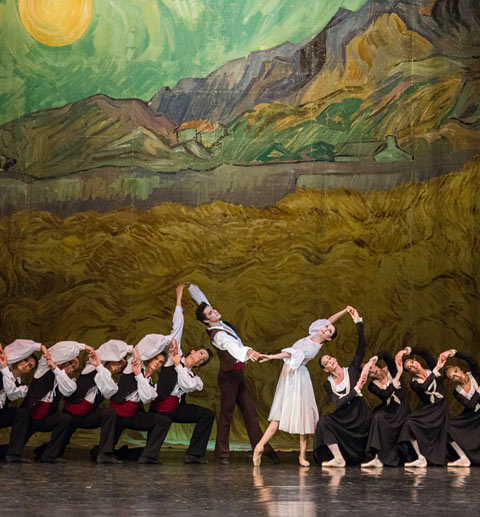
© Stephanie Berger. (Click image for larger version)
The mixed program included yet another work, Roland Petit’s L’Arlésienne, that uses music recently featured by a choreographer at New York City Ballet. Christopher Wheeldon’s Les Carillons, set to the same Bizet score, was a suite, whereas Petit’s is a kind of deconstructed story ballet from which much of the plot seems to be missing. What is left is a happy peasant wedding that quickly goes sour, though we never really understand why (in the original Daudet story, the protagonist, Frédéri, finds out that his beloved has slept with another man). It’s a kind of Jeune Homme et la Mort set in the French countryside instead of a grungy garret apartment: the protagonist spends most of the ballet tearing at his clothes and going out of his mind, until finally, after a very exciting, crazed solo—a real mad scene—he commits suicide. (Both Jérémie Bélingard, on July 11, and Benjamin Pech, on the 12th, performed with admirable soulfulness and abandon.) Petit’s peasant dances are pretty and clever, with lots of funny shuffles, flexed feet, and turned in toes, but the ballerina (Isabelle Ciaravola on the 11th, Nolwenn Daniel on the 12th) has little to do but pine and caress her man and show off her beautiful feet. The real raison d’être of the ballet is its final solo, which is truly spectacular. The exhausted dancer playing Frédéri goes on a rampage of open-chested leaps, arms flying, hands grabbing at the air. After a wild crescendo, he stares into the audience’s eyes and then turns away, runs, and leaps through the window at the back of the stage, to his death. The ballet ends with a bang and the crowd goes wild.
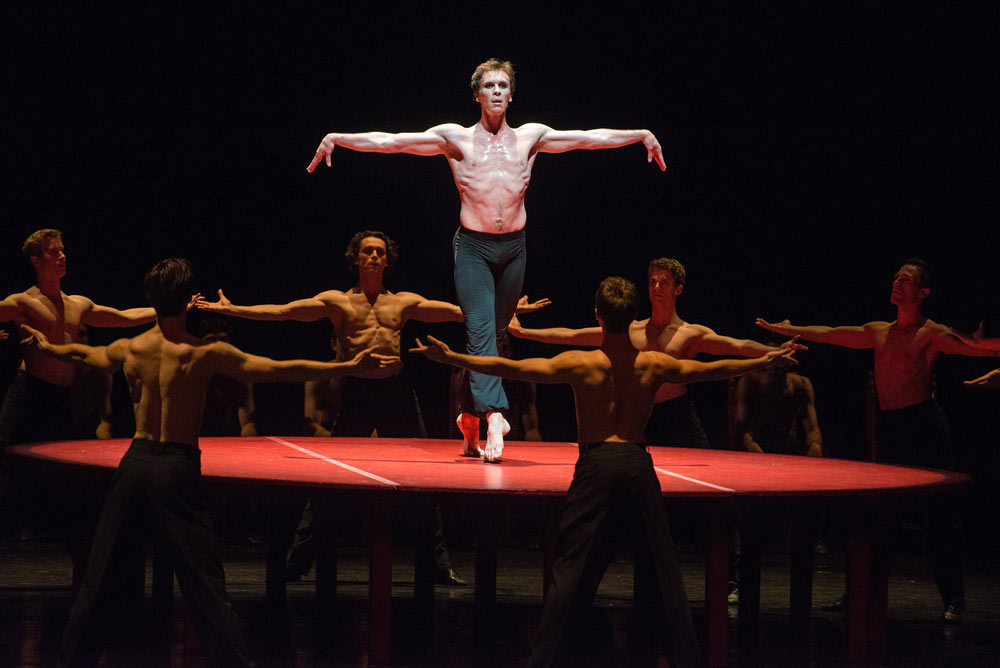
© Stephanie Berger. (Click image for larger version)
But no-one knows how to whip an audience into a lather quite like Béjart. His Boléro is a triumph of erotic kitsch, a lap dance in the guise of high art. At the center of the stage stands a red table, upon which a shirtless man pulses his legs forward and back, while slowly raising his arms, hands like cobra heads, then rubs his chest and thighs, staring out at the audience suggestively all the while. He puts his hand under his chin, as if blowing kisses, frames his crotch with his palms, pulses his bare and increasingly sweaty chest. Who can resist? All around him, men sit in high-backed chairs, caressing their chests and opening their legs as if becoming increasingly aroused. Then they begin to stand up in twos and threes to do their own bump and grind, stalking the object of their adoration, ready to pounce. Over-the-top and vulgar as it is, it fits the music perfectly—after all, Ravel composed it for a similarly exotic dance performed by the vampy Ida Rubinstein in Paris in 1928. Béjart’s Boléro represents the exaltation of the dancer as the utlimate sex symbol. The dance can be performed by a man or a woman. On July 12, the majestic Marie-Agnès Gillot managed to class it up a bit, but on the 11th, Nicolas Le Riche, one of the company’s senior stars, was fabulously predatory, a raging furnace of self-love and sex appeal. One imagines that after the show he must have ravaged a hundred virgins, but maybe he simply went home and soaked his feet in the tub, but in any case, he was magnificent, good taste (and choreography) be damned.
Tomorrow, Giselle.













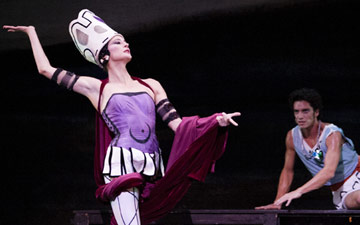

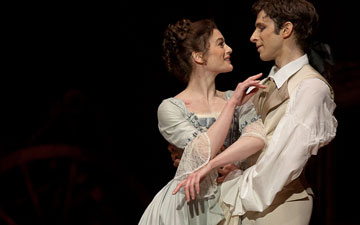

A correction: The Frederi on July 12th was not Mathieu Ganio, but Benjamin Pech. My apologies. (The review text is now updated. Ed)
From Maurice Béjarts book “Un instant dans la vie d’autrui. Mémoires“, published in 1979.
“With “Bolero“, I thought less about Spain which one associates with the title, but of the Orient which is hidden in the partitura; it was important for me to expose the melody, which keeps pressing forward, relentlessly rolling in like a wave. The rhythm, for which the melody serves as an incentive, allows itself to be lured and makes promises, constantly increasing its volume and intensity. All strength will be spent when at the end the rhythm devours the melody. The “Bolero“ is a history of desire.
(…) So I watched, changing with the season and the tour, the wonderfully extensive Duska Sifnios, saucily showing off an infantile narcissism. I saw Tania Bari, mysteriously withdrawn into herself, not so much a vestal virgin in her movements, but an unknown goddess: she was not dancing, but brooding about my choreography. Then there was Angèle Albrecht on the shoulders of the boys, who tragically injured herself, or Maya Plisetskaya, subtly playing hide and seek with herself, as if she wanted to please Mallarmé. The “Bolero“ became a Rorschach test.
The version I preferred in this test (but this is absolutely subjective), was maybe the one of Suzanne Farrell. When Suzanne danced the “Bolero“, the ballet was refined and reformed. I did not have to watch a sacred or voluptuous monster, Suzanne revived what I had envisioned. She was dancing like a streaming source, she managed to reunite the famous antipodes, the Angel and the Animal, the Virgin and the Wanton. She was precise and musical, she made the music her own, embodying it. Her body became the music.
(…) Jorge Donn became the successor to Duska and Bari. “Successor“ is the wrong word: the ballet received a different meaning. Forty girls around a table that became a cultic site, they made me think of priestesses. “Bolero“ became a variation about the theme Dionysos and the Maenads. The girls wore black, long skirts. Whereas the boys around the female dancer displayed their desire, the girls seemed to make a ceremony out of it whose object and goal was Donn – a pagan god or some last survivor. I had not changed a single movement in the choreography that I had created 18 years earlier for Duska Sifnios.“
Forgive me the clumsy language – this was translated from the German version of the French book, just to let you Americans know that this ballet is not just about sex and bumping hips, that there may be different ideas in it – for example the combat of melody and rhythm which appears in none of the reviews I have read. Béjart was a philosopher and is so often misjugded in the Anglo-American ballet world.
[Despite the company’s prestige, the American public seldom gets to glimpse the art of French dancers; in recent years, for example, no French étoiles have appeared in American Ballet Theatre’s guest-studded spring seasons at the Met.]
I think the problems lies, not surprisingly, with the ABT management. As Aurelie Dupont mentions in here interview for Time Out New York,
‘About one month ago, I e-mailed ABT [American Ballet Theatre], which is a company I love. And I know that ABT invites dancers from everywhere. They have a lot of Russians, they have a lot of Royal Ballet, they have many, many dancers and very good dancers. So I sent a little e-mail and said, “You’re performing Eugene Onegin by [John] Cranko, and I just did it in Paris, and I love dancing this ballet. I don’t know if it’s possible, but I would love to join the company and dance with you.” And they said no, that they were not interested.’
[…] In July, the Paris Opéra Ballet came to NY, where it offered three programs, including one in which it presented three works from the twentieth century: Serge Lifars’s Suite en Blanc, Roland Petit’s L’Arlesienne, and, most fun, Maurice Béjart’s Bolero. You can read my DanceTabs review here. […]